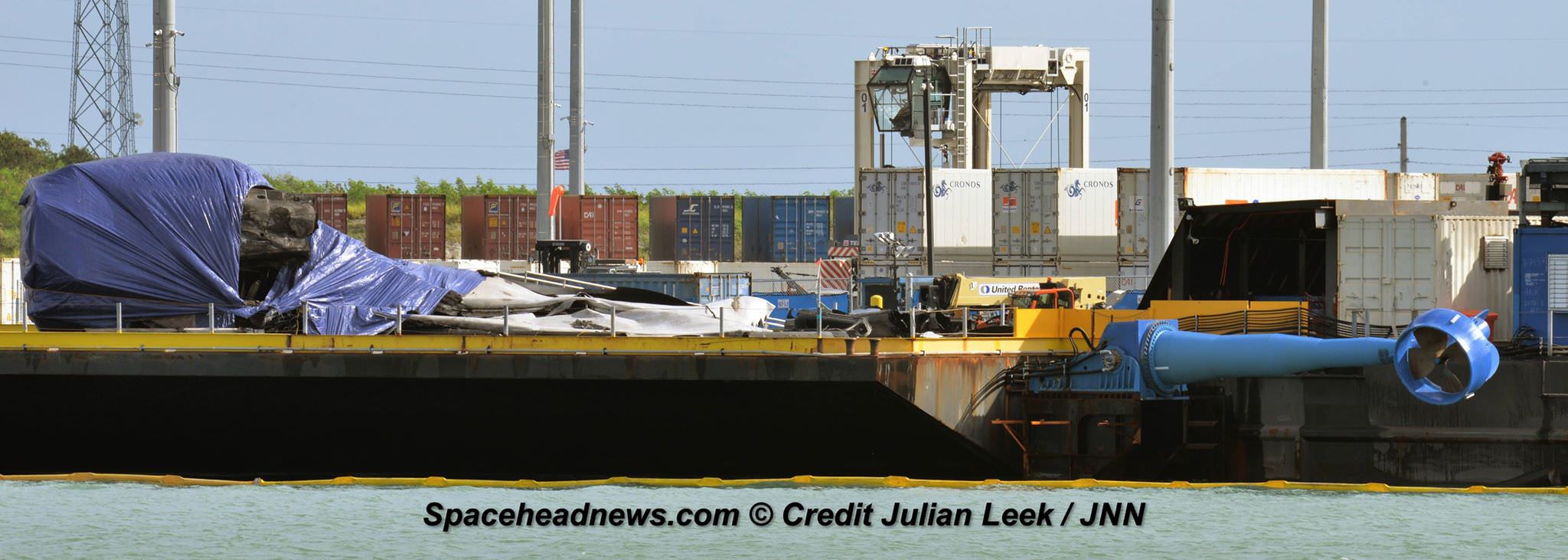
CAPE CANAVERAL AIR FORCE STATION, FL — The pancaked leftovers of a SpaceX Falcon 9 first stage from last week’s successful commercial launch but hard landing at sea, pulled silently and without fanfare into its home port over the weekend – thereby ending a string of three straight spectacular and upright soft ocean landings over the past two months.
The residue of the Falcon sailed into home port at Port Canaveral, Fl under cover of darkness and covered by a big blue tarp late Saturday night, June 18, at around 9 p.m. EDT.
It arrived atop SpaceX’s ASDS drone ship landing platform known as “Of Course I Still Love You” or “OCISLY” – that had already been dispatched several days prior to the June 15 morning launch from the Florida space coast.
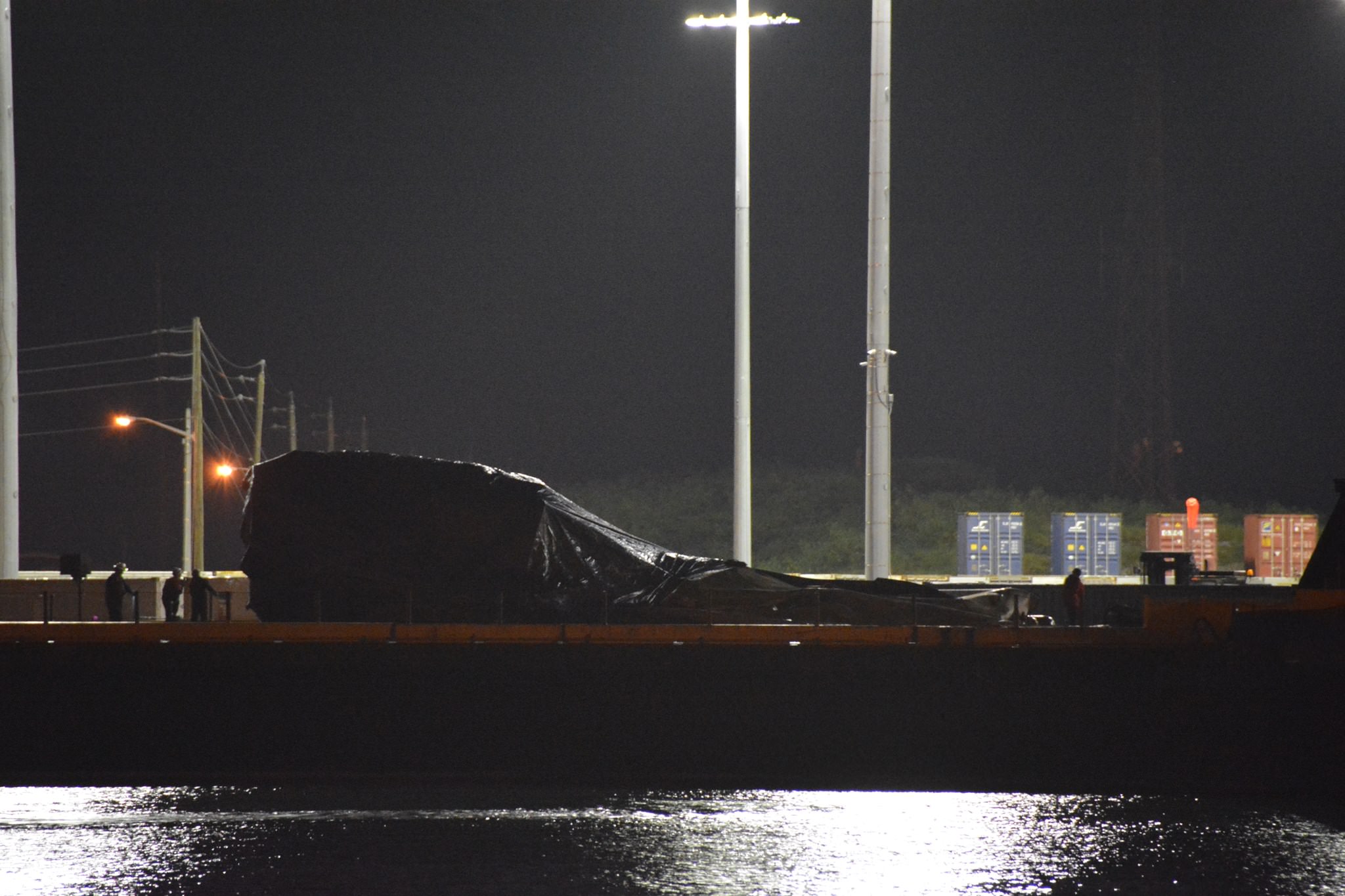
And check out this exquisite hi res aerial video of the tarp ‘Blowing in the Wind’ – showing an even more revealing view of the remains of the Falcon 9 after much of the tarp was blown away by whipping sunshine state winds.
Video Caption: SpaceX booster remains from Eutelsat-ABS launch seen in Port Canaveral on 06-19-2016 the day after arrival. The wind blew off part of the tarps covering what is left of Eutelsat-ABS booster. Credit: USLaunchReport
Recovering and eventually reusing the 156 foot tall Falcon 9 first stage to loft new payloads for new paying customers lies at the heart of the visionary SpaceX CEO Elon Musk’s strategy of radically slashing future launch costs and enabling a space faring civilization.
The latest attempt to launch and propulsively land the Falcon booster on a platform a sea took place on Wednesday, June 15 after the on time liftoff at 10:29 a.m. EDT (2:29 UTC) from Space Launch Complex 40 on Cape Canaveral Air Force Station in Florida.
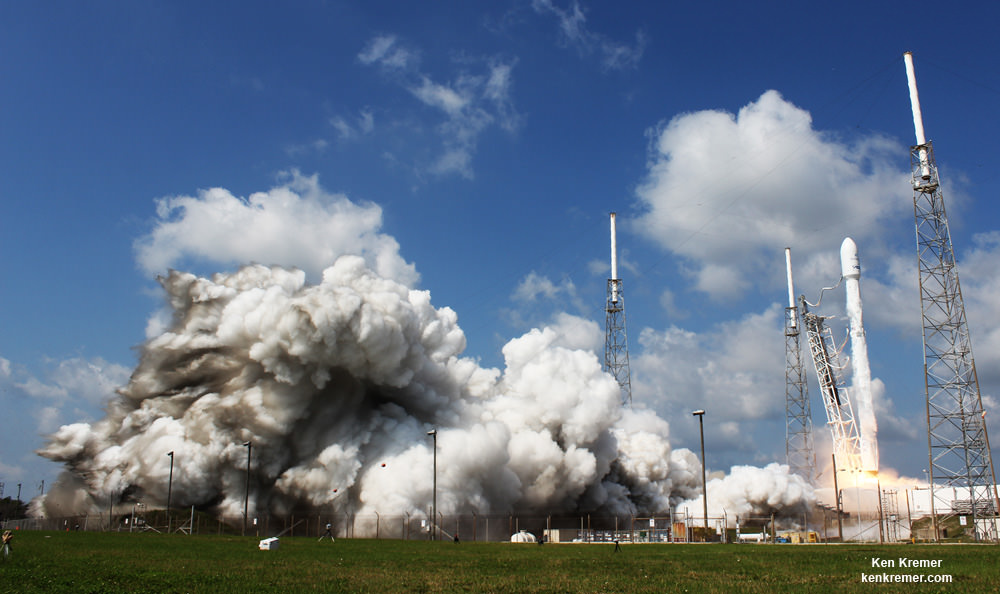
The 229 foot-tall (70 meter) Falcon 9 successfully accomplished its primary goal of delivering a pair of roughly 5000 pound commercial telecommunications satellites to a Geostationary Transfer Orbit (GTO) for Eutelsat based in Paris and Asia Broadcast Satellite of Bermuda and Hong Kong.
The Falcon 9 delivered the Boeing-built EUTELSAT 117 West B and ABS-2A telecommunications satellites to orbits for Latin American and Asian customers.
“Ascent phase & satellites look good,” SpaceX CEO and founder Elon Musk tweeted.
After first stage separation, SpaceX engineers attempted the secondary and experimental goal of soft landing the 15 story tall first stage booster nine minutes after liftoff, on an ocean going ‘droneship’ platform for later reuse.
OCISLY was stationed approximately 420 miles (680 kilometers) off shore and east of Cape Canaveral, Florida in the Atlantic Ocean.
However, for the first time in four tries SpaceX was not successful in safely landing and recovering the booster intact and upright.
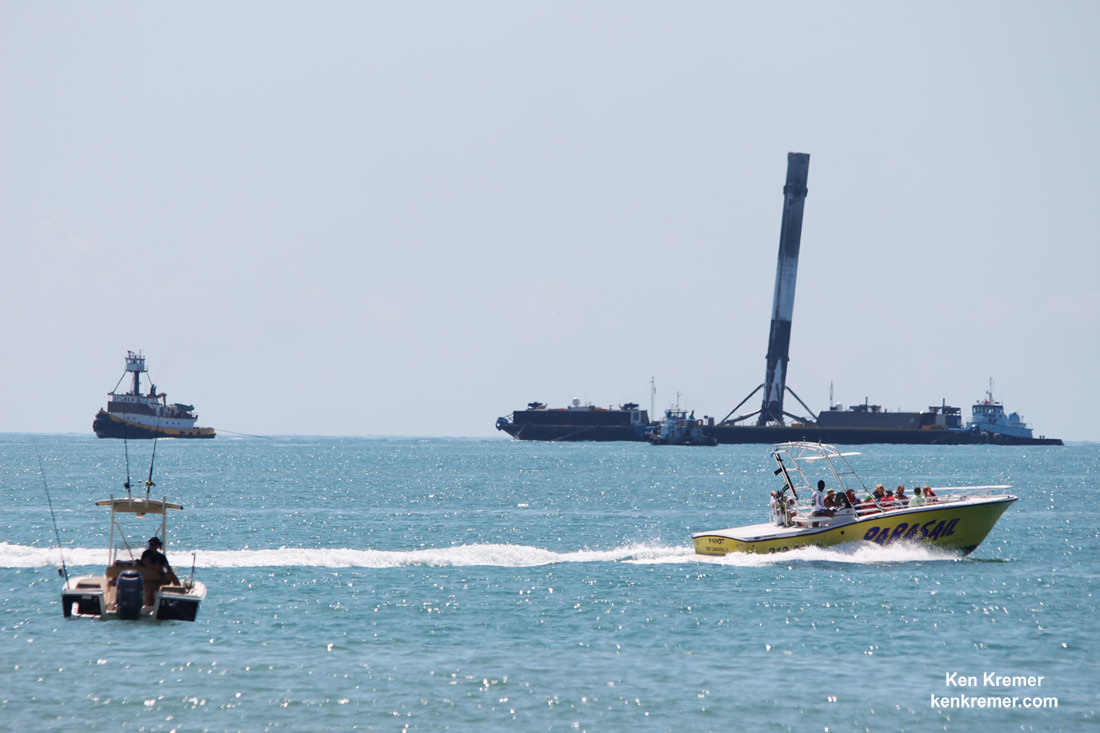
The booster basically crashed on the drone ship because it descended too quickly due to insufficient thrust from the descent engines.
The rocket apparently ran out of fuel in the final moments before droneship touchdown.
“Looks like early liquid oxygen depletion caused engine shutdown just above the deck,” Musk explained via a twitter post.
The first stage is fueled by liquid oxygen and RP-1 propellant.
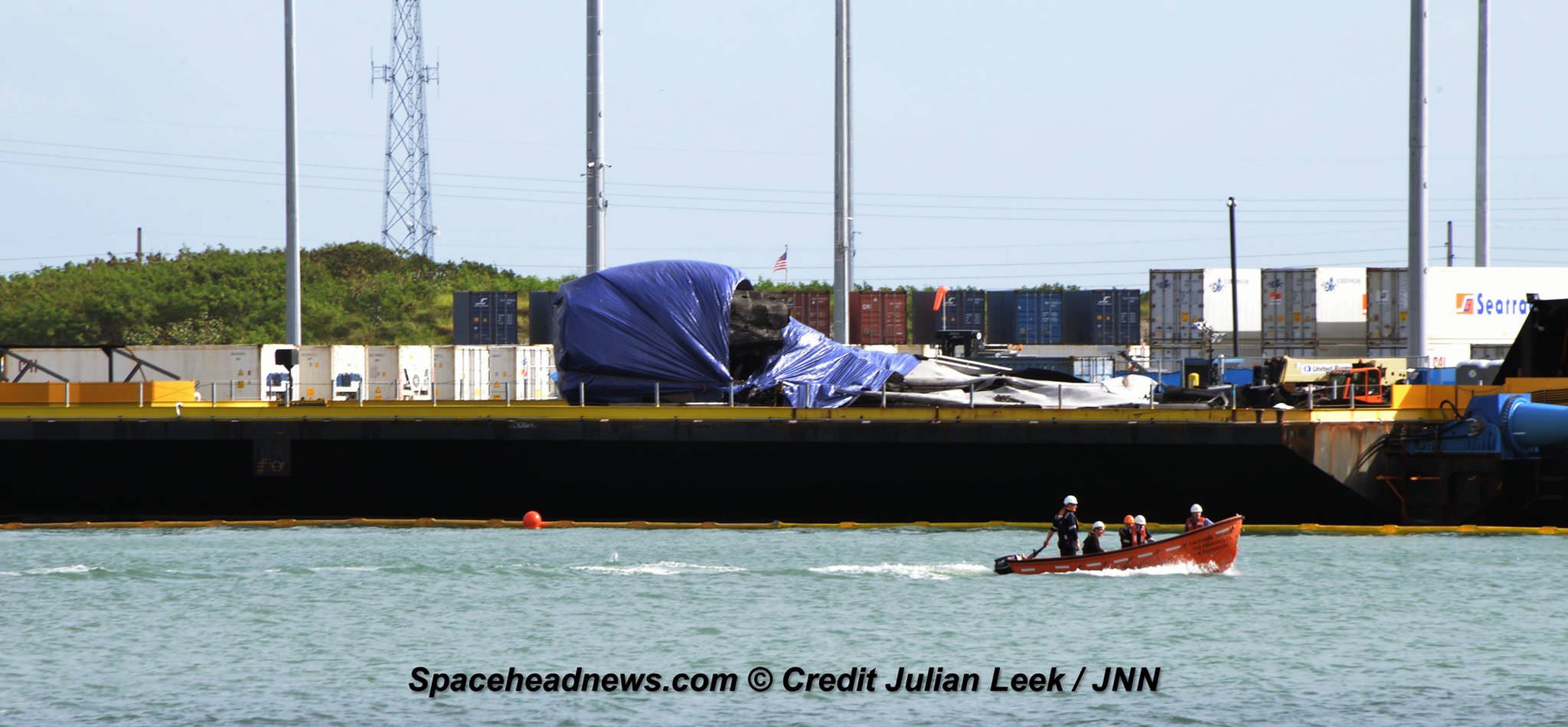
A SpaceX video shows a huge cloud of black smoke enveloping the booster in the final moments before the planned touchdown – perhaps soot from the burning RP-1 propellant.
In the final moments the booster is seen tipping over and crashing with unrestrained force onto the droneship deck – crushing and flattening the boosters long round core and probably the nine Merlin 1D first stage engines as well.
“But booster rocket had a RUD on droneship,” Musk noted. RUD stands for rapid unscheduled disassembly which usually means it was destroyed on impact. Although in this case it may be more a case of being crushed by the fall instead of a fuel related explosion.
“Looks like thrust was low on 1 of 3 landing engines. High g landings v sensitive to all engines operating at max,” Musk elaborated.
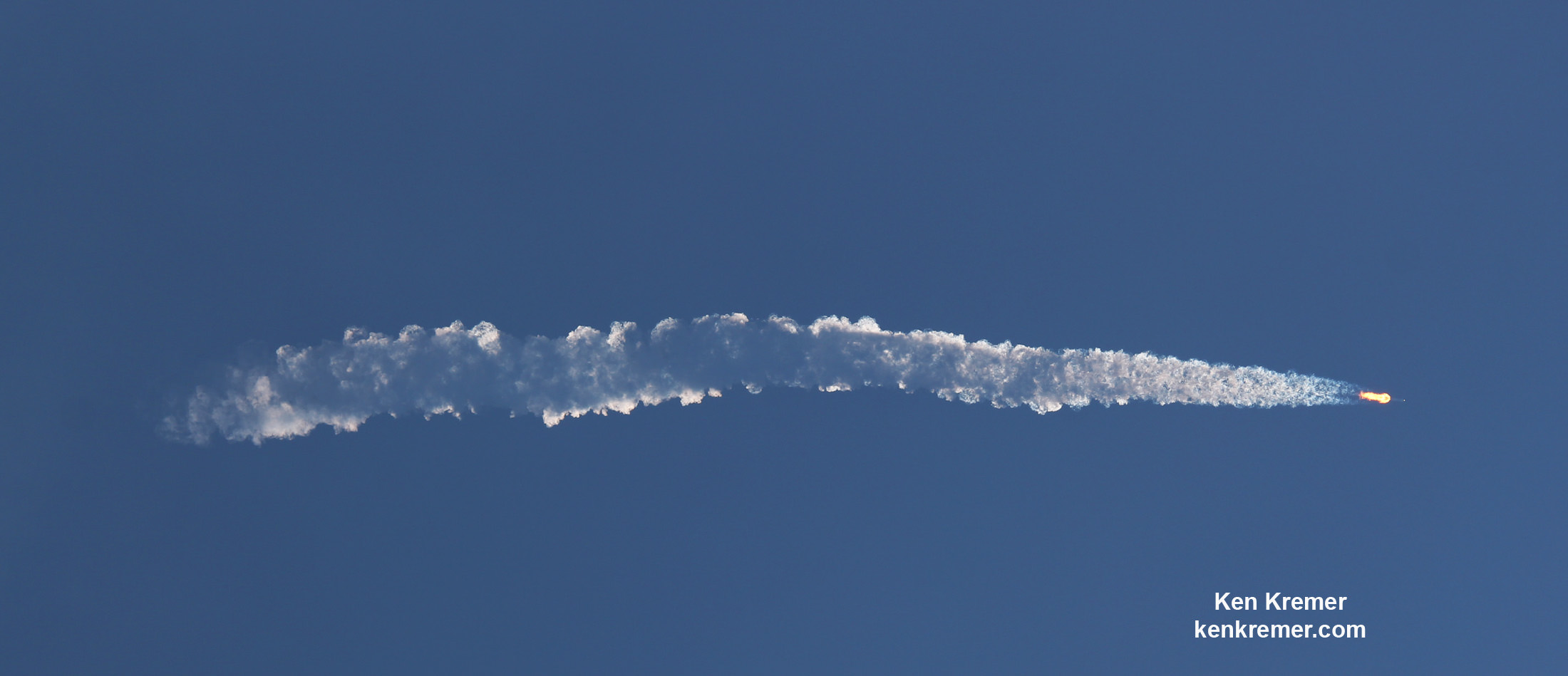
The June 15 crash follows three straight landing successes at sea – on April 8, May 6 and mostly recently on May 27 after the Thaicom-8 launch. See my onsite coverage here of the Thaicom-8 boosters return to Port Canaveral on the OCISLY droneship.
Yet this outcome was also not unexpected due to the high energy of the rocket required to deliver the primary payload to the GTO orbit.
“As mentioned at the beginning of the year, I’m expecting ~70% success rate on landings for the year,” Musk explains.
And keep in mind that the rocket recovery and recycling effort is truly a science experiment on a grand scale financed by SpaceX – and its aiming for huge dividends down the road.
“2016 is the year of experimentation.”
It’s a road that Musk hopes will one day lead to a human “City on Mars.”
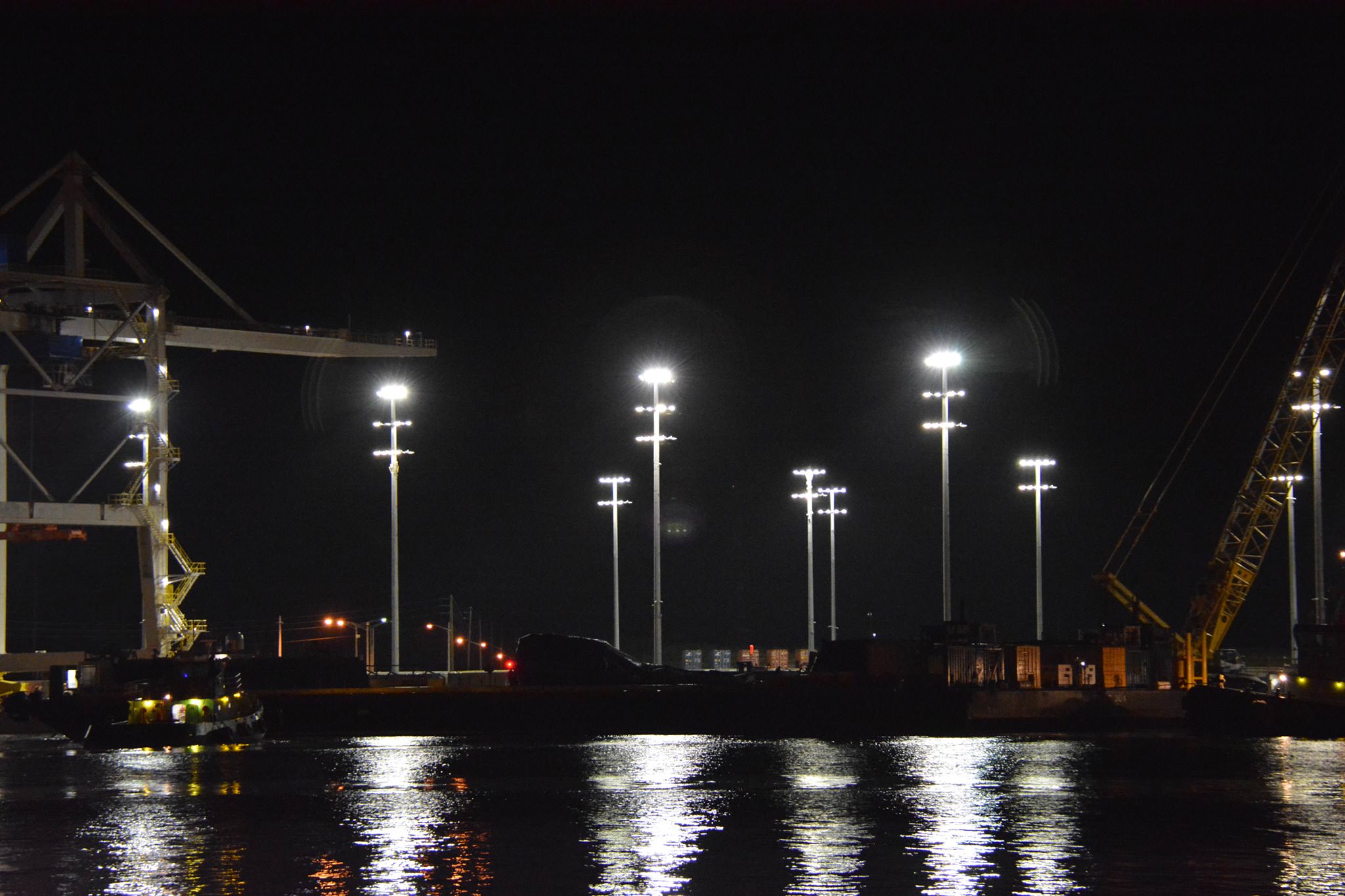
Stay tuned here for Ken’s continuing Earth and planetary science and human spaceflight news.
Watch these incredible launch videos showing many different vantage points:
Video caption: SpaceX Falcon 9 launch video compilation – Eutelsat and ABS satellites launched on 06/15/2016 from Pad 40 CCAFS. Credit: Jeff Seibert
Video caption: SpaceX Falcon 9 lifts off with Eutelsat 117W/ABS-2A electric propulsion comsats on June 15, 2016 at 10:29 p.m. EDT from Space Launch Complex 40 at Cape Canaveral Air Force Station, Fl, as seen in this up close video from Mobius remote camera positioned at pad. Credit: Ken Kremer/kenkremer.com

Careful, detailed engineering analysis would preclude this trial-and-error method of design which seems to be SpaceX’s engineering method. I get the feeling that I’m watching an old 3-Stooges show every time we witness the results of this trial-and-error. “Dooh! We forgot to calculate how much fuel we need. Let’s add more fuel next time and see what happens”. That is not what I call engineering. I bet there are a few engineers who DO know how to run these calculations but are they overworked to the point that leads them to make mistakes? Is it Elon’s pressure to slap things together quickly and not waste time doing calculations?
Sure, it can all be done using math and a computer and it will just work in real life… ask any good engineer or weather forecaster 😉
That’s ridiculous… How many other rocket manufacturers can you name that have successfully orbited satellites then landed the booster? Who else is even trying? Blue Origins might eventually, but at present all their flights have been sub-orbital.